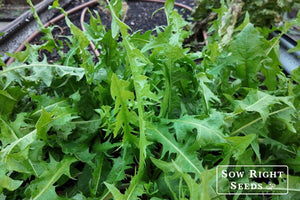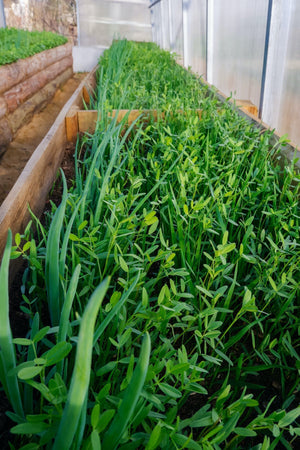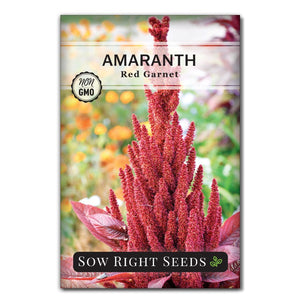Grow Red Garnet Amaranth From Seed for Colorful Flowers and Protein-Packed Grain
AmaranthMaybe you’ve seen beautiful red amaranth in floral arrangements. Or you’ve seen amaranth listed as a gluten-free grain. And perhaps you’ve wondered if this is something you could grow. The good news is that this gorgeous plant is easy to grow and can be enjoyed in many ways.

Nutritional Benefits of Red Amaranth
Amaranth is known for its exceptional nutritional profile, packed with protein, fiber, and a variety of essential vitamins and minerals. This ancient grain has been cultivated for thousands of years and was a staple food for the Aztecs and Incas. It contains all nine essential amino acids, making it a complete protein source. Amaranth is also rich in iron, magnesium, phosphorus, and potassium.
Not only is amaranth nutritious, but it is also naturally gluten-free, making it a great option for those with dietary restrictions. Its high fiber content aids digestion and promotes a healthy gut. Additionally, amaranth is a good source of antioxidants, which help protect against oxidative stress and inflammation.
History and Cultivation of Amaranth
Amaranth has a long history dating back thousands of years. It was originally cultivated in Central and South America and was an important crop for the Aztecs and Incas. The grain was used in religious ceremonies and was believed to have supernatural powers. When the Spanish conquistadors arrived, they banned the cultivation of amaranth due to its association with indigenous rituals.
Fortunately, amaranth has made a comeback in recent years and is now grown worldwide. It thrives in warm climates and can tolerate a wide range of soil conditions. Amaranth plants are known for their beautiful, vibrant colors, with varieties ranging from deep red to golden yellow. The plant produces both edible leaves and grains, making it a versatile addition to any garden.
How to grow Amaranth from seed
Amaranth is easy to grow from seed. In fact, the plant will sow its own seeds and keep producing if left alone.
Amaranth seeds can be started indoors or direct sown as long as the soil temperature is 60ºF and above.
Plant amaranth seeds outdoors after all danger of frost is passed.
Seeds can be started indoors 6 to 8 weeks before the last spring frost.
Plant amaranth seeds 1/8” deep. Keep the seeds moist until they have sprouted.
Once they’ve sprouted, water from the bottom to avoid damping off.
When the seedlings are several inches tall and have been hardened off, they can be transplanted outdoors.
When transplanting amaranth, space plants 6 to 12” apart.
Tips for fail-proof amaranth seed germination
Amaranth seeds are very small. To plant them with space between, use a toothpick to plant 2 to 3 seeds per pot or growing cell.
Amaranth is a heat-loving plant and needs warm soil to germinate. Keep soil temperature at 65 - 75ºF for indoor germination.
Seeds need to stay moist to germinate. Using a humidity dome will keep moisture in and prevent the seeds from drying out.
How to Grow Amaranth Plants
It thrives in warm climates and can tolerate a wide range of soil conditions.
Amaranth is an adaptable plant that thrives in warm climates. It can tolerate a wide range of soil conditions as long as the soil doesn’t stay too wet. Amaranth has been cultivated worldwide.
Amaranth plants need full sun in any location, which means at least 6 hours of daily sunlight. It loves the heat and will be damaged by frost.
Like most flowers, amaranth needs fertile, well-draining soil. Usually, 1 inch of water a week is sufficient. If the soil stays too wet, the roots can rot.
Amaranth will continue blooming until the first frost. To encourage continuous blooms, pinch back and deadhead flowers. You may also want to succession plant for a continual crop of flowers.
Solutions for amaranth pests and diseases
Amaranth is an easy plant to grow. Like many other plants, it can be susceptible to common pests such as aphids. Use natural ways to get rid of aphids to keep your amaranth plants edible.
Nutrient-rich garden soil will give amaranth plants the right amount of nutrients for healthy growth. Keeping the soil moist but not water-logged will prevent root rot.

Harvesting Amaranth
Amaranth can be harvested for multiple uses. Harvest the leaves early for a nutritious vegetable. Cut amaranth blooms for flower arrangements. Harvest the dried amaranth seeds for a gluten-free grain. You can even choose not to harvest your amaranth plants and leave the seeds to feed the birds.
Harvesting amaranth for floral arrangements
Growing amaranth in a cut flower garden is a beautiful way to enjoy this colorful plant. To harvest amaranth blooms for floral arrangements, cut the stalks when about ¾ of the flowers have opened on the spikes. Cutting flowers in the early morning while they are fully hydrated is also crucial. This will keep them from wilting and help them last longer.
The colorful amaranth flowers can also be dried for preserved floral arrangements. Red Garnet amaranth is valued for its ability to keep its bright color even as a dried flower.
When drying flowers, hang them upside down so the stalks dry straight.
Harvesting amaranth grain
Harvest amaranth seed heads once they begin to turn brown. Cut the spikes and place them in a paper bag to dry completely. Once they are dry, shake the bag to separate the grain. You can blow off the chaff before eating the seeds.
Harvesting amaranth greens
Amaranth leaves are a healthy way to eat amaranth. The young leaves are more tender and much like spinach. Larger leaves harvested after the flowers bloom have a different taste and will be better steamed or added to stews.

Storing amaranth grain
Once the amaranth seeds have dried, they can be stored in an airtight container. They will keep for a few months at room temperature. If stored in the freezer, amaranth grain should last for six months before becoming rancid.
Amaranth FAQs
Is red amaranth good to eat?
Amaranth is very nutritious both as a leafy vegetable and as a grain. The vitamin and mineral content of the leaves is much like spinach and other leaf vegetables. Amaranth grain or seed is a complete protein and gluten-free.
Is red amaranth a perennial?
Amaranth is an annual, but it will self-sow. If left to go to seed in the garden, you will have amaranth plants sprouting up next spring.
Can red amaranth be eaten raw?
Both the leaves and the amaranth seeds can be eaten raw. They can also both be cooked.
So our only question is - What category does Amaranth go in? Is it a flower? Grain? Or leafy green? I guess we’ll have to use it as all three! It’s definitely something to try growing in your garden. Shop now for heirloom amaranth and enjoy this excellent crop in any way you want.
Did you find this information helpful? Share it with your gardening friends!







Thank you for insight full information.
Leave a comment